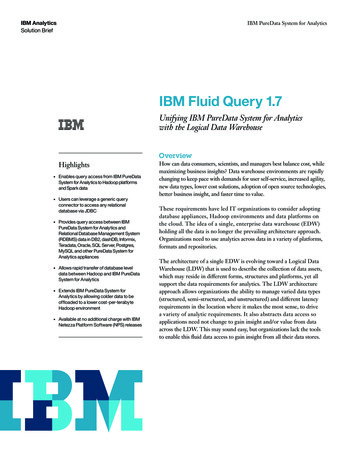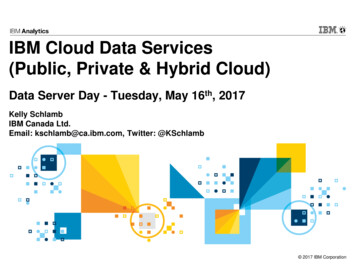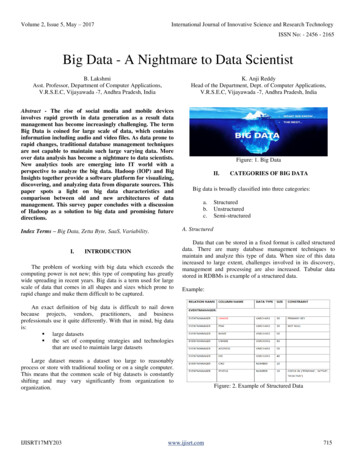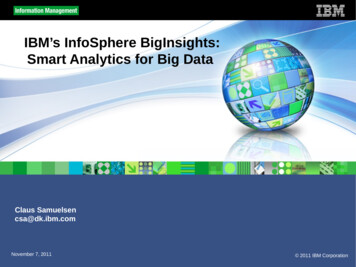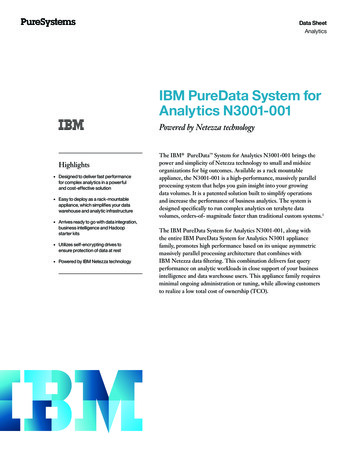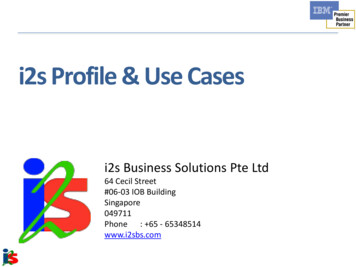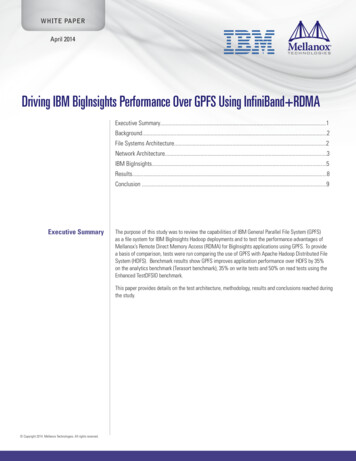
Transcription
WHITE PAPERApril 2014Driving IBM BigInsights Performance Over GPFS Using InfiniBand RDMAExecutive Summary.1Background.2File Systems Architecture.2Network Architecture.3IBM BigInsights.5Results.8Conclusion .9Executive SummaryThe purpose of this study was to review the capabilities of IBM General Parallel File System (GPFS)as a file system for IBM BigInsights Hadoop deployments and to test the performance advantages ofMellanox’s Remote Direct Memory Access (RDMA) for BigInsights applications using GPFS. To providea basis of comparison, tests were run comparing the use of GPFS with Apache Hadoop Distributed FileSystem (HDFS). Benchmark results show GPFS improves application performance over HDFS by 35%on the analytics benchmark (Terasort benchmark), 35% on write tests and 50% on read tests using theEnhanced TestDFSIO benchmark.This paper provides details on the test architecture, methodology, results and conclusions reached duringthe study. Copyright 2014. Mellanox Technologies. All rights reserved.
WHITE PAPER: Driving IBM BigInsight Performance Over GPFS Using InfiniBand RDMABackgroundpage 2“Big Data” has become the hot “buzz word” in contemporary data store and analysis discussions.“Big Data” can be described as data that does not easily fit into a traditional Relational DatabaseManagement System (RDBMS) because of the sheer volume of data or because it does not have awell-defined structure of rows and columns or clearly defined data types. Large Web 2.0 companies werethe first to encounter these enormous data sets and their seminal efforts have evolved into the ApacheHadoop framework. The rest of the industry is now in the midst of a tremendous transformation trying tocope with ever growing and more complex data. Companies are searching for ways to extract actionableintelligence from this vast data set in the shortest time possible. This means that system architects needto figure out how to address the challenges of capturing, curating, managing and processing this data.IBM is solving the challenge of Big Data with the innovative and powerful IBM BigInsights product builton an underlying Hadoop architecture.The Hadoop framework is composed of two core blocks. The first is the Hadoop Distributed File System(HDFS) that provides a scalable storage mechanism for vast amounts of data. The second is a frameworkthat provides an analytics component called MapReduce that organizes the mining of data stored on thefile system. The Hadoop architecture is going through a rapid adoption phase presenting a new set ofchallenges that customers are now facing. The architecture presented in this document can provide asolution for continuous data ingestion or write heavy workloads problems.Analytic edictiveAnalysisContentAnalysisIBM Big Data PlatformVisualizationand DiscoveryApplicationsand emStreamComputingDataWarehouseInformation Integration and GovernanceCloudMobileSecurityFigure 1: IBM Big Data PlatformFile SystemsArchitectureWhile HDFS is a component of the Apache Hadoop package it has several short-comings which can beovercome by replacing HDFS with another file system. One such approach offered by IBM with BigInsightsis the IBM General Parallel File System (GPFS).General Parallel File SystemGPFS is an IBM product which was first released in 1998. GPFS is a high performance enterprise classdistributed file system. Over the years it has evolved to support a variety of workloads and can scale tothousands of nodes. GPFS is deployed and used in many enterprise customer production environments tosupport machine critical applications. 2014 Mellanox Technologies. All rights reserved.
WHITE PAPER: Driving IBM BigInsight Performance Over GPFS Using InfiniBand RDMApage 3GPFS Applications: Digital media Engineering design Business intelligence Financial analytics Seismic data processing Geographic information systems Scalable file servingGPFS Features: Seamless capacity expansion to handle the extreme growth of digital information and improveefficiency through enterprise wide, interdepartmental information sharing High reliability and availability to eliminate production outages and provide disruption-freemaintenance and capacity upgrades Performance to satisfy the most demanding applications Policy-driven automation tools to ease information lifecycle management (ILM) Extensible management and monitoring infrastructure to simplify file system administration Cost-effective disaster recovery and business continuity POSIX (Portable Operating System Interface) compliantHadoop Distributed File SystemHDFS is the intrinsic distributed file system provided as part of the Apache Hadoop package. HDFS datais distributed across the local disks of multiple computers which are networked together. The computerscontaining the data are referred to as data nodes. Data nodes are typically homogeneous with eachhaving multiple hard disks. Each file written to HDFS is split into smaller blocks and distributed across thedata nodes. By default, HDFS is configured for 3-way replication to ensure data reliability.HDFS Features Simple installation Block size & replication can be changed during the file creation Inherent reliability Designed for Hadoop workloads write once and read many timesNetwork ArchitectureInfiniBand & RDMAInfiniBand provides a messaging service that applications can access directly without requiring theoperating system. Compared to a TCP/IP byte-stream oriented transport, InfiniBand eliminates the needfor a complex exchange between an application and the network. Direct access means that an applicationdoes not need to rely on the operating system to transfer messages. This “application-centric” approachto computing is the key differentiator between InfiniBand and TCP/IP networks. 2014 Mellanox Technologies. All rights reserved.
WHITE PAPER: Driving IBM BigInsight Performance Over GPFS Using InfiniBand RDMApage 4Figure 2: Messaging architecture in InfiniBand fabricThe current speed of InfiniBand FDR is 56Gb/s with communication latency of less than 1us fromapplication to application.A key capability of InfiniBand is Remote Direct memory Access (RDMA). RDMA provides direct applicationlevel access from the memory of one computer into the memory of another computer without requiringany services from the operating system on either computer. This enables high-throughput, low-latency,and low CPU transport overhead node to node communication which is critical in massively parallelcomputing clusters. As shown in the InfiniBand architecture in Figure 3 the software transport interfacesits just above the transport layer. The software transport interface defines the methods and mechanismsthat an application needs to take full advantage of the RDMA transport service.Figure 3: InfiniBand Architecture 2014 Mellanox Technologies. All rights reserved.
WHITE PAPER: Driving IBM BigInsight Performance Over GPFS Using InfiniBand RDMApage 5SX6036 Switch System OverviewThe SX6036 switch systems provide the highest-performing fabric solutions in a 1RU form factor by delivering 4.032Tb/s of non-blocking bandwidth to High-Performance Computing and Enterprise Data Centers, with200ns port-to-port latency. Built with Mellanox’s latest SwitchX -2 InfiniBand switch device, the SX6036provide up to 56Gb/s full bidirectional bandwidth per port. This stand-alone switch is an ideal choice for topof-rack leaf connectivity or for building small to medium sized clusters. It is designed to carry converged LANand SAN traffic with the combination of assured bandwidth and granular Quality of Service (QoS).The SX6036 with Virtual Protocol Interconnect (VPI) supporting InfiniBand and Ethernet connectivity providethe highest performing and most flexible interconnect solution for PCI Express Gen3 servers. VPI simplifiessystem development by serving multiple fabrics with one hardware design. VPI simplifies today’s network byenabling one platform to run both InfiniBand and Ethernet subnets on the same chassis.ConnectX -3 Pro Dual-Port Adapter with Virtual Protocol Interconnect OverviewConnectX-3 Pro adapter cards with Virtual Protocol Interconnect (VPI) supporting InfiniBand and Ethernetconnectivity provide the highest performing and most flexible interconnect solution for PCI Express Gen3servers used in Enterprise Data Centers, High-Performance Computing, and Embedded environments.Clustered data bases, parallel processing, transactional services and high-performance embedded I/Oapplications will achieve significant performance improvements resulting in reduced completion timeand lower cost per operation.IBM BigInsightsIBM BigInsights V2.1 release introduced support for GPFS File Placement Optimizer (FPO). GPFS FPO is aset of features that allow GPFS to support map reduce applications on clusters with no shared disk.GPFS-FPO Benefits Locality awareness so compute jobs can be scheduled on nodes containing the data Chunks that allow large and small block sizes to coexist in the same file system to make themost of data locality Write affinity allows applications to dictate the layout of files on different nodes to maximizeboth write and read bandwidth Distributed recovery to minimize the effect of failures on ongoing computationThe table below shows the benefits of GPFS over HDFS to put the performance expectation into perspective. 2014 Mellanox Technologies. All rights reserved.FeatureHDFSGPFSDifferent file size handlingSupports only very large blocksizes.Wide range of supported filesizes with stable performanceacross the file size spectrum.POSIX ComplianceNoYesManagement and High AvailabilityNo support for high availabilitymetadata until version 2.0, adhoc management toolComplete high availabilitysupport, standard interface andautomation tools for management
WHITE PAPER: Driving IBM BigInsight Performance Over GPFS Using InfiniBand RDMApage 6Improving Hadoop Resiliency and PerformanceWhen using HDFS, as shown in Figure 4 below, the metadata is managed by one master node whichis called the NameNode. A NameNode failure may mean complete data loss. However, architecturessuch as IBM BigInsights provide a High Availability (HA) design to eliminate this Single Point of Failure(SPOF). Specifically, IBM BigInsights includes support for NameNode HA implemented since BigInsightsV2.1 release. Some implementations use Network File System (NFS) with a Secondary NameNodewhich does not provide a complete HA but is a reasonably quick manual recovery option in case of aNameNode failure.Figure 4: Hadoop HDFS ArchitectureAs of the time of writing this paper, HDFS 1.2 does not support tiered storage (mixing of different sizesand types of storage devices). That means that the file system treats all storage identically and is unableto optimize overall application performance based on the type of storage being used. For example, theslowest component in a Hadoop node is the spinning disk which provides max throughput of about 100200MB/s per device. During a continuous data ingest, these disks become the bottleneck and using fastSSD’s may not be cost effective when storing petabytes of data.GPFS offers a solution to these challenges. Figure 5 shows that the very concept of a NameNodegoes away when GPFS is used for Hadoop map reduce. Every node has equal access to metadata andmetadata can be replicated in the same manner as data for reliability. Furthermore GPFS provides theflexibility of mixing storage devices. There can now be SSD’s in the 1st tier, fast 10K RPM SAS storagein the 2nd tier, and 7.2K RPM SATA drives in the 3rd tier. 2014 Mellanox Technologies. All rights reserved.
WHITE PAPER: Driving IBM BigInsight Performance Over GPFS Using InfiniBand RDMApage 7Figure 4: Hadoop Architecture Incorporating GPFSFigure 4: Hadoop Architecture Incorporating GPFSFigure 5: Hadoop GPFS ArchitectureUsing GPFS for MapReduce workloads has many benfits over HDFS: Eliminates the single point of failure of the NameNode without requiring a costly high availability design Provides tiered storage so you can place data on the right type of storage (SSD, 15k SAS , 7200RPM NL/SAS or any other block device) Use native InfiniBand RDMA for better throughput, lower latency and more CPU cycles for yourapplicationTo get the best price performance for MapReduce workloads use IBM BigInsights with GPFS and leverage SSD, SAS and SATA drives capabilities.Benchmark SetupTwo equally sized five node clusters with IBM BigInsights were used for comparison, one had HDFSand the other GPFS. Both clusters had file system metadata stored in SSD’s. The goal was to compareHadoop Map Reduce performance on HDFS vs. GPFS.Both clusters used the same underlying Infiniband fabric. At the time of this test HDFS does not supportRDMA so TCP/IP over Infiniband (IPoIB) was used for node to node communication. The GPFS clustersetup used the RDMA capabilities of the file system.The complete technical details and nuances of the deployment will be published in a separate technicaldocument. 2014 Mellanox Technologies. All rights reserved.
WHITE PAPER: Driving IBM BigInsight Performance Over GPFS Using InfiniBand RDMAResultspage 8TeraSort Benchmark ResultsTeraSort is a well-known Hadoop benchmark. TeraSort uses a map reduce job to sort 1TB of data asquickly as possible. TeraSort stresses both the file system and MapReduce layers of Hadoop. Figure 6shows the 1TB TeraSort results. The test ran 35% faster on GPFS than it did on HDFS.Fig 6: Data analtyics performance results comparison,higher numbers show better resultsHiBench Enhanced DFSIO ResultsHiBench is a benchmark suite that contains a variety of Hadoop tests. Enhanced DFSIO, from theHiBench suite, tests file system performance for sequential read and write workloads measuring themaximum throughout of the file system. Fig 7 shows the write throughput performance using the EDFSIO test, as in the TeraSort test the cluster using GPFS provided 35% faster throughput than the HDFScluster. Figure 8 shows the read throughput performance using E-DFSIO test. In this test GPFS was 50%faster than HDFS.Figure 7: Write performance, higher numbers show better results 2014 Mellanox Technologies. All rights reserved.
WHITE PAPER: Driving IBM BigInsight Performance Over GPFS Using InfiniBand RDMApage 9Figure 8: Read performance, higher numbers show better resultsConclusionThe E-DFSIO tests demonstrate, on the benchmark systems used, that there is a clear IO performancebenefit to using GPFS instead of HDFS with a 35% performance improvement on write and a 50% performance improvement on read. The goal of this project was to measure the benefits of GPFS utilizingInfiniBand RDMA for a continuous data ingest (write) workload. In addition, GPFS performs better on theanalytics portion (based on the Terasort benchmark) with 35% gain demonstrating the combined workloadbenefits of data retrieval, storage and data analytics.On the benchmark system, GPFS provided better performance than HDFS. The measured performanceimprovements along with the fact that GPFS is POSIX compliant, contains a rich set of administrative toolsand has a proven track record of reliability make it a compelling file system choice for map reduce workloads. The high performance requirements for Big Data applications are fulfilled with an infrastructureprovided by Mellanox interconnects, the enterprise capabilities of IBM Biginsights and IBM GPFS. 2014 Mellanox Technologies. All rights reserved.
WHITE PAPER: Driving High Performance out of IBM BigInsight over GPFS Using InfiniBand RDMApage 10Special NoticeThe information contained in this document has not been submitted to any formal IBM test and is distributed AS IS. The use of this information or the implementation of any of these techniques is a customerresponsibility and depends on the customer’s ability to evaluate and integrate them into the customer’soperational environment. While each item may have been reviewed by IBM for accuracy in a specificsituation, there is no guarantee that the same or similar results will be obtained elsewhere. Customersattempting to adapt these techniques to their own environments do so at their own risk.Any performance data contained in this document were determined in various controlled laboratory environments and are for reference purposes only. Customers should not adapt these performance numbersto their own environments as system performance standards. The results that may be obtained in otheroperating environments may vary significantly. Users of this document should verify the applicable datafor their specific environment.For more od ib switch ducts dyn?product family 161&mtag connectx 3 pro vpi tem Brochure.pdfFor more information about IBM InfoSphere BigInsights, For more information about IBM GPFS FPO, visit:ibm.com/systems/software/gpfs350 Oakmead Parkway, Suite 100, Sunnyvale, CA 94085Tel: 408-970-3400 Fax: 408-970-3403www.mellanox.com 2014 Mellanox Technologies. All rights reserved.Mellanox, ConnectX, SwitchX, Virtual Protocol Interconnect are registered trademarks of Mellanox Technologies, Ltd. All other trademarks are property of their respective owners.
intelligence from this vast data set in the shortest time possible. This means that system architects need to figure out how to address the challenges of capturing, curating, managing and processing this data. IBM is solving the challenge of Big Data with the innovative and powerful IBM BigInsights product built on an underlying Hadoop .
